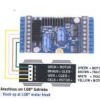stevedenver
Registered
its an LGB trolley. same basic motor block as a stainz.Does this car have the same drive as the pignose railcar?
If so, look to the long spring-strips, which centre the drive..
PhilP
After a read up on basic electronics, i think i fried a diode. which was my first thought.
i do recall running it full throttle to get it back so i could answer the phone indoors.
but having removed unsoldered each diode and still having the short, it doesnt fit.....
nevertheless, it has to be a component failure.
im just not trouble shooting the circuit correctly by pulling out diode and resistor ends. an unsoldering the light boards.
plan on getting some replacements for the lighting board diodes today, and im betting that will do it.
apparently if you fry a diode, especially the little glass ones i think , as used in the lighting boards, with excess voltage the thing melts and conducts both ways......
ill keep at it. i know ill get it, but only by frustrating trial and error...im sure its stupidly simple and obvious , but not to me.
and tried the catenary switch/setting...same short.
Last edited:

